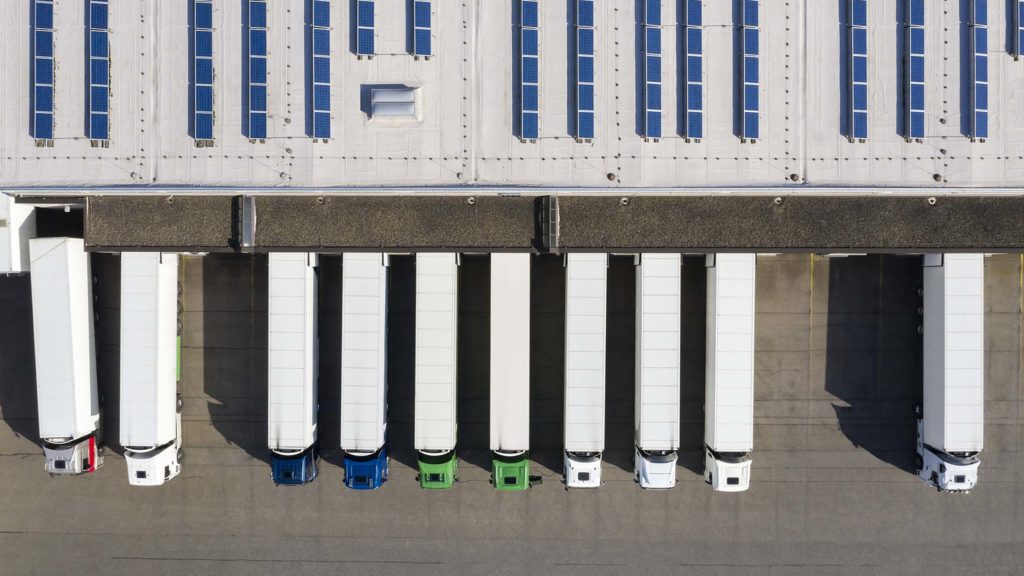Posted On February 6, 2023
When it comes to shipping products, speed and efficiency are essential. Companies are always looking for ways to improve their supply chain, reduce transportation costs and get their products to customers faster.
Cross-docking is a logistics strategy that can help you streamline the shipping process and reduce or eliminate warehousing and storage costs. But is it the right solution for your company?
This blog post will explore the pros and cons of cross-docking and how it can help you make the most of your shipping operations.
Stay ahead of the curve. Flat World’s newsletter sends quick logistics updates and advice biweekly. Sign up to stay informed.
What is cross-docking?
Cross-docking takes place when goods are received from a carrier’s or supplier’s truck at a docking terminal and then quickly loaded onto outbound trucks heading for their final destination, eliminating the need for long-term storage. Shipments are usually consolidated or deconsolidated at the facility before being loaded back onto a truck for the next leg of the journey.
It all happens at the cross-docking facility (often a warehouse with a cross-docking system in place) within 24-48 hours.
Sometimes the term cross-docking is used interchangeably with transloading, where goods are transferred from one mode of transportation to another—for example, from a truck onto a train. Within this article, however, the term cross-docking is only referring to goods being transferred from truck to truck within a short amount of time. And it’s unlike traditional warehousing, where goods are received at the warehouse, inventoried and stored until they’re shipped out on an as-ordered basis.
Two types of cross-docking
Pre-distribution: In pre-distribution cross-docking, the cross-docking happens early in the supply chain, where goods are sorted and loaded before they leave the supplier and already have delivery instructions.
Post-distribution: During the post-distribution cross-docking process, goods leave the supplier and transfer to a dedicated distribution center, cross-docking terminal or cross-docking warehouse, where they will re-sort and combine orders and items for transport.
Why do companies use cross-docking?
Cross-docking is a popular option to reduce costs and transportation times, especially for high-volume shipping companies. Dock workers can combine pallets from multiple suppliers and quickly move them to the final destination with fewer trips. It eliminates the need for extra storage or inventory space. Order fulfillment happens rapidly and efficiently, speeding up the process, reaching the end customer faster and improving customer satisfaction.
Cross-docking is especially helpful for international shipments to Canada and Mexico. When companies are transporting cross-border shipments, cross-docking allows the consolidation of inbound and outbound shipments to reduce customs compliance paperwork and border fees. For example, instead of sending five different pallets to Canada, a shipper could coordinate all of the pallets to arrive at a cross-docking facility near the Canadian border and consolidate them into one shipment. From there, the shipper would only have to pay for customs brokerage and transportation of one shipment instead of five, and they could deconsolidate the shipment after it’s successfully entered into Canada.
Use case examples
Cross-docking can be incorporated into a supply chain for various reasons, depending on the situation and industry. The following are a few instances of how different industries use cross-docking:
- Retail cross-docking: Retail companies use cross-docking to consolidate goods from multiple suppliers into a single shipment. They can move cargo faster since there is little to no warehouse management required.
- Food and Beverage cross-docking: By moving perishable goods rapidly through the supply chain with little or no storage, cross-docking reduces delays, and thus the risk of food spoilage.
- Manufacturing cross-docking: Instead of filling inventory storage with raw materials days or weeks before they are needed, cross-docking allows the automotive industry to execute just-in-time deliveries, so production only starts when an order comes in.
- Chemicals: Transporting chemical products is expensive and dangerous due to their specific storage requirements. By cross-docking, they are handled as little as possible, and no long-term storage space is required.
Industry news, expedited. Biweekly, we’ll send you exactly what you need to know about supply chains and nothing else. Sign up now.

The pros and cons of using cross-docking in your supply chain
Companies looking to streamline their shipping operations will find that a cross-docking solution offers many advantages. Still, there are a few challenges to also keep in mind.
Pro: Storage cost savings
Warehousing is a critical part of the supply chain. However, it comes with its own costs, such as labor, rent, maintenance and utilities. Cross-docking offers a solution to reduce those costs by eliminating the need for long-term storage, instead transferring cargo from one transport to another for immediate shipment. By streamlining the transfer process, cross-docking can reduce expenses, leading to cost savings.
Pro: Quick turnaround times
When time is of the essence, cross-docking can be a major help.
Dock workers move goods quickly from incoming transport to outbound delivery vehicles at a cross-docking facility, often in less than 24 hours. Rather than unloading goods, scanning inventory into a warehouse management system (WMS), and storing them for an extended period of time, the cargo is received, consolidated or deconsolidated and loaded onto another truck.
Consider the scenario of a container arriving in Los Angeles from China two months late. Initially, the company may have planned to move the container by rail to the Midwest, where it would be unloaded and sorted, before sending some of the goods back to their final destination on the West Coast. In this situation, cross-docking can help make up for some of the lost time from the container’s overseas journey. If the company cross-docks the shipment in Los Angeles, they can unload the goods and immediately send the West Coast cargo to its destination instead of waiting for it to travel to the Midwest and back again.
Pro: Less freight handling
Another benefit of cross-docking is reduced freight handling, decreasing the risk of damage. By eliminating the need to move goods into and out of storage, there is less potential to mangle or misplace goods.
Con: The potential for higher shipping costs
While some shippers can save money by using cross-docking, they need to ship a large volume of products to make it cost-effective. By nature, cross-docking for less-than-truckload shipments will often cost more than other transportation options like truckload shipments (TL) or rail.
There is a lot of planning and precise execution that needs to happen with cross-docking. If at any time, the process starts backing up because inbound and outbound transportation is late or goods aren’t unloaded or loaded fast enough, it can cause significant disruptions on the dock. Those interruptions can lead to both delays in delivery and additional fees (like inventory holding costs) levied by the cross-docking company.
Con: Tight timelines & lack of visibility
Another potential drawback to cross-docking is visibility. Most goods don’t get scanned into a warehouse management system when they’re at the facility, and shippers may experience a window without shipment updates. Instead, these shipments deal mainly with a paper trail and require checking each carrier’s tracking website separately, which can take a great deal of time.
Con: Shipment & material handling
Just like cost, how packages are physically handled at the inbound dock could also cause issues. With the rapid transition from truck to dock to truck, shippers have less control over cargo handling and packaging, which increases the potential risk of damaged orders. Depending on the items you’re shipping, if they require special packaging or handling, the docking facility might be unable to accommodate them. Make sure the cross-docking partner you’re considering working with is equipped to handle your goods.

How to get started with the cross-docking process
While cross-docking is an excellent solution for businesses looking to improve their supply chain operations, it’s essential to understand the entire process before getting started. It requires careful planning and execution to be successful because it relies on several parties moving quickly and on time.
Companies should assess the size and scope of their needs, analyze the cost of cross-docking services, and determine if the savings are worth it in the long run. Perhaps it could be more beneficial as a one-off solution, as needed.
Additionally, companies should consider how their current ERP (enterprise resource planning) or TMS (transportation management system) would integrate with their cross-docking strategy. As mentioned above, with cross-docking mainly dealing in paper trails, it’s important to know how your company will manage and monitor goods during transit.
An experienced logistics partner can help you implement cross-docking efficiently and effectively. They should have a thorough understanding of your business needs and an in-depth knowledge of the latest technologies and trends in supply chain management. Cross-docking is a powerful tool, but it pays to do your due diligence and find the right partner.
If you have questions or want to learn more, contact us.

